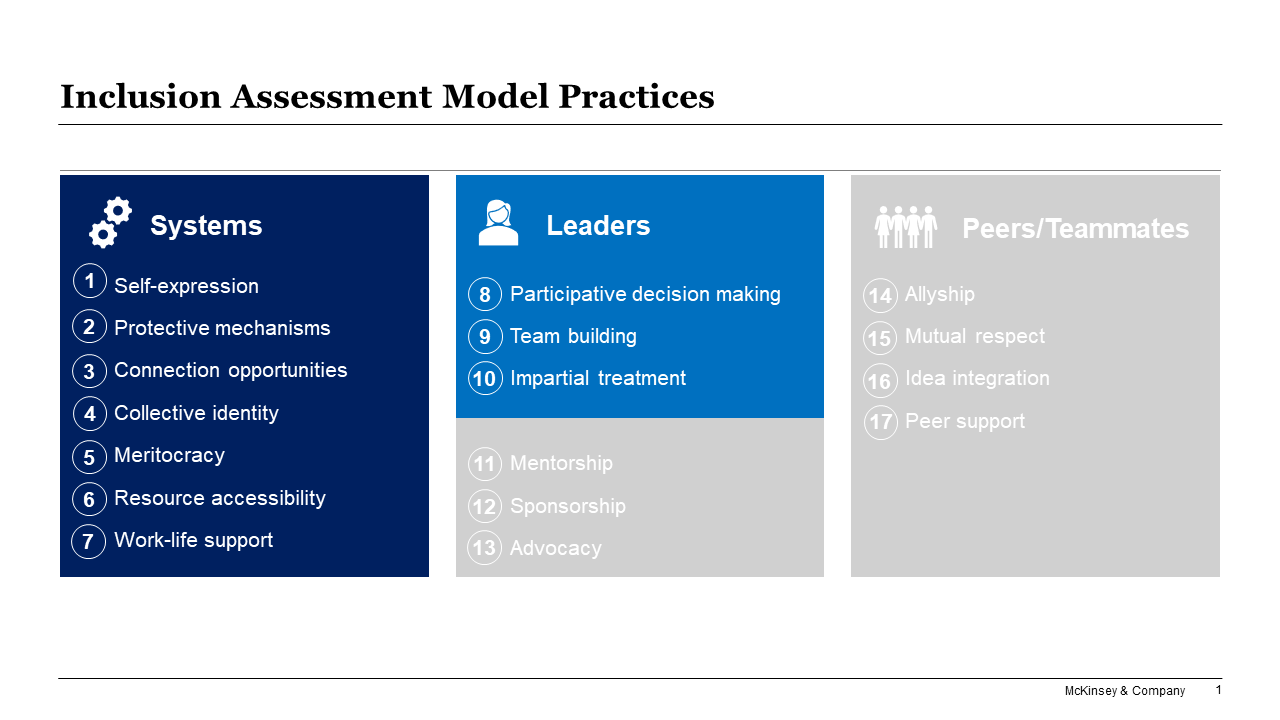Most companies define inclusion too narrowly and thus address it too narrowly as well. Over the past three years, we've broadened our perspective on how to create truly inclusive workplaces and inspired the development of a modern and revolutionary inclusion model. The model includes 17 practices (i.e., frequency of desired behaviors) and six outcomes (i.e., perceptions of effectiveness) that form the backbone of the inclusion assessment, a well-validated survey that makes it easier to turn insights into actions.
Each practice in this model is individually important and, taken together, they impact both aspects of workplace inclusion: employees’ perceptions of the organization’s inclusivity—the focus of this post—and their personal experiences. Each practice falls into one of three relationships that shape workplace inclusion: organizational systems, leaders, and peers/teammates.
Enterprise perceptions of inclusion are driven by seven organizational systems practices and three leader practices.

Organizational systems: more than no-tolerance policies
The organizational systems practices—supported by research from multiple fields, including organizational justice and social identity—provide the process and execution guardrails for a robust diversity, equity, and inclusion (DE&I) strategy.
- Self-expression: Creating a space for all employees to express themselves in ways that are personally meaningful.
- Protective mechanisms: Discouraging inappropriate, disrespectful, or biased behaviors at work and providing employees a safe way to report such behaviors.
- Connection opportunities: Creating opportunities for employees to get to know one another and develop interpersonal relationships across the organization.
- Collective identity: Uniting all employees around an overarching purpose.
- Meritocracy: Creating objectives and consistent processes for personnel decisions and merit-based rewards.
- Resource accessibility: Providing all employees with equal access to information, opportunities, and relationships they need to be successful.
- Work-life support: Showing appreciation for employees’ non-work demands, responsibilities, and interests.
COVID-19 has brought unprecedented challenges, including how to shape and sustain inclusion in work environments that have largely gone remote. Employers must consider new ways to progress their DE&I-related goals.
For instance, a financial services firm launched organization-wide events that connected people despite distance, increased funding for affinity groups, and introduced a sponsorship program to provide resources through “broken-rung” transitions.
Measuring inclusion and using the data to drive action has helped organizations improve inclusion despite changing conditions.
Leaders: key enablers of the organizational system
Inclusive workplaces also rely on leaders to act as role models, translators, and signals of organizational values and priorities. Leaders can shape positive perceptions by employing three practices stemming from research on mentoring, inclusive leadership, and justice.
- Participative decision making: Encouraging and incorporating a broad set of ideas and input from all colleagues.
- Team building: Fostering trust, collaboration, and healthy conflict among team members to build bonds.
- Impartial treatment: Treating all employees fairly when allocating resources and making decisions.
We often talk with HR professionals about how to address the conflict between their bias-mitigating, well-structured talent processes and managers’ preference for informal ways of hiring and promoting, which can undermine even the best efforts. A federal organization targeted this issue by investing in extensive leader capability building around their talent processes. Training in proper usage of decision-making systems, particularly when the approach is data-backed, helps ensure leaders are positioned to shape positive perceptions of workplace inclusion.
Enterprise inclusion: how it looks and feels when done right
Inclusion is a multi-faceted construct that must be addressed comprehensively. A truly inclusive workplace implements systems that minimize bias, allowing employees to express themselves and connect with each other. It also features leaders who not only advocate for team members and treat them impartially but also uphold and support all organizational systems and practices.
The 17 practices, when done consistently well, drive workplace inclusion and equity for all employees by providing clarity into actions that matter. Our next post in this series will turn to the personal experience of inclusion and its seven related practices for leaders and peers/teammates.
The authors would like to thank Diana Ellsworth, Vidya Mahadevan, David Mendelsohn, and Bill Schaninger for their meaningful contributions to this post.


